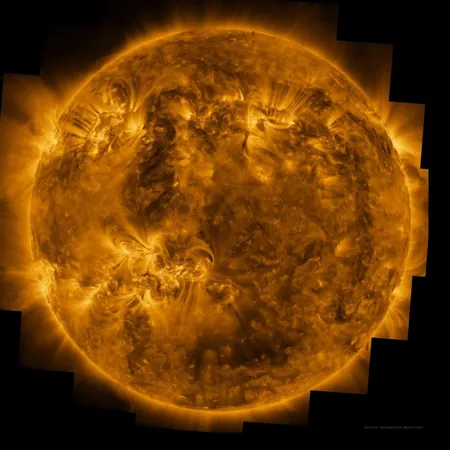
Stunning New Images Reveal the Sun in Unprecedented Detail – See the Fiery Details!
2024-11-25
Author: Wei Ling
Stunning New Images Reveal the Sun in Unprecedented Detail
The majestic sun, often too brilliant for the naked eye to perceive—even from an awe-inspiring distance of nearly 92 million miles—has been captured in remarkable detail thanks to the pioneering efforts of the European Space Agency's Solar Orbiter. Recently released images, hailed as the highest-resolution views of the solar surface to date, have left scientists and space enthusiasts alike astonished.
Captured in March 2023, four extraordinary images showcase our star in all its fiery splendor. These images were obtained during a close flyby of the Solar Orbiter, which is stationed approximately 46 million miles from the sun—essentially halfway between our planet and the sun's blazing heart. Each image was meticulously taken over the span of four hours, offering various angles that collectively unveil the sun's intricate layers.
With an impressive arsenal of instruments, the Solar Orbiter not only documented the sun's grainy photosphere in visible light but also mapped its magnetic fields and tracked the flow of superheated materials across its surface. Among the dazzling array of visuals is a breathtaking ultraviolet light image that highlights the corona, the sun's outermost layer, where temperatures soar to about 1.8 million degrees Fahrenheit.
Key Revelations from the Images
This unique vantage point allowed the spacecraft to tilt and rotate with precision, creating a stunning mosaic that portrays the full disc of our sun. Here’s what these sensational new images reveal:
1. The Active Corona
The UV images spot various sunspot regions, where glowing plasma erupts, indicating magnetic activity. These active areas are the origins of solar flares, which can have profound effects on space weather and satellite operations on Earth.
2. Understanding Sunspots
Sunspots are fascinating dark patches that appear on the sun’s luminescent surface, revealing cooler regions that emit less light due to the magnetic interruptions of heat transfer. The images bring to life how these sunspots serve as windows into the complex magnetic dynamics of our star.
3. Magnetic Maps
As part of the incredible discovery, researchers created a magnetic map, or “magnetogram,” highlighting concentrated magnetic fields around sunspots. These areas are crucial for understanding solar activity and can illuminate the science behind phenomena such as solar storms and their potential impact on Earth.
4. Surface Material Movement
The Solar Orbiter also produced a velocity map showcasing the motion of solar materials. The detailed color-coding indicates how plasma flows—blue represents movement toward the spacecraft, while red denotes movement away. Interestingly, this illustrates that while the sun's surface moves in concert with its rotation, material is expelled around sunspots, influencing solar dynamics.
The Solar Orbiter’s groundbreaking findings not only deepen our understanding of solar mechanics but also pave the way for enhanced predictive models of space weather. These developments are increasingly vital in an age where solar activity can affect everything from GPS systems to power grids on Earth.
Stay tuned as new data continues to emerge from this cutting-edge mission, promising even more revelations about the sun's secrets and the nature of our universe!




 Brasil (PT)
Brasil (PT)
 Canada (EN)
Canada (EN)
 Chile (ES)
Chile (ES)
 España (ES)
España (ES)
 France (FR)
France (FR)
 Hong Kong (EN)
Hong Kong (EN)
 Italia (IT)
Italia (IT)
 日本 (JA)
日本 (JA)
 Magyarország (HU)
Magyarország (HU)
 Norge (NO)
Norge (NO)
 Polska (PL)
Polska (PL)
 Schweiz (DE)
Schweiz (DE)
 Singapore (EN)
Singapore (EN)
 Sverige (SV)
Sverige (SV)
 Suomi (FI)
Suomi (FI)
 Türkiye (TR)
Türkiye (TR)